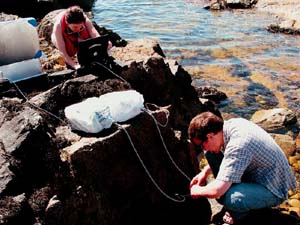| 2004 |

|
YEAR BOOK |
National University of Ireland, Galway
|
Algal ecophysiology and ecotoxicology at NUI, Galway
|

|
|
In situ
photosynthesis studies on marine lichens
|
Current research in the Department of Botany, Martin Ryan Institute, NUIG, focuses on the ecology and physiology of marine macroalgae (seaweeds), with particular emphasis on environmental stresses and impacts such as pollution (ecotoxicology). Research has concentrated on assessments of the environmental control of seaweed productivity and distribution, algal phenology and ecotypic differentiation, the biology of introduced species (e.g., the alien seaweed Sargassum muticum ), and algal-fungal interactions. Experimental approaches are used to study physiological responses to stress, as well as adaptations and acclimations of plants to micro-habitats with different temperature, irradiance, nutrient and osmotic regimes.
Physiological ecology and phenology
Seasonal growth and reproductive patterns have been assessed in ecologically and economically important seaweeds, e.g., the Knotted Wrack Ascophyllum nodosum, the Thongweed Himanthalia elongata, and the edible red seaweed Dulse, or Dillisk, Palmaria palmata. Candidate strains for aquaculture have been selected from European shores by assessing their physiological tolerances to photoinhibition, pigment bleaching and temperature extremes prevailing in different biogeographic regions.
Pollution studies: bioindicators and bioassays
Species-specific characteristics of metal uptake in relation to phylogeny, morphology and physiology are under investigation to facilitate an effective choice of bioindicator species in future biomonitoring. A macroalgal bioassay for metal contamination was developed using chlorophyll a fluorescence, a rapid, non-intrusive, and most importantly, ecologically relevant assessment of photosynthetic activity. This involved the identification of suitable, sensitive but stable species, the careful selection of experimental conditions, and a comparison of the sensitivity of the results with that of traditional bioassays.
Algal-fungal interactions
Research supported by the NUIG Millennium Fund concentrates on osmotic and temperature responses of marine lichens (see photograph ). But also some seaweeds are ubiquitously infected with fungi; these include the well-known commercial species Ascophyllum nodosum and Pelvetia canaliculata (Channelled Wrack). Such algal-fungal associations are highly sensitive to environmental change, and excess nutrients from sewage and low salinities can reduce seaweed productivity. Collaborative research with Dr Maria Tuohy (Department of Biochemistry, NUIG) focuses on identifying key carbohydrates and proteins involved in marine algal-fungal interactions. Although potentially stressing their hosts by sequestering algal carbohydrates, the presence of fungi also makes algae more resistant to environmental stress, e.g., by stimulating the production of sugaralcohols involved in osmoregulation. Understanding the physiological pathways of marine algal-fungal associations may help identify biomarkers for environmental stress (e.g., from organic and inorganic pollution), which in the future could be used as sensitive indicators for anthropogenic impacts in the marine environment.
Contact: Dr Dagmar B Stengel, Department of Botany, Martin Ryan Institute, NUI, Galway;
E-mail: [email protected]